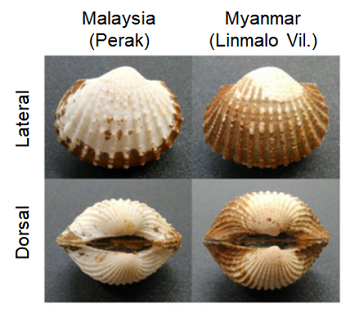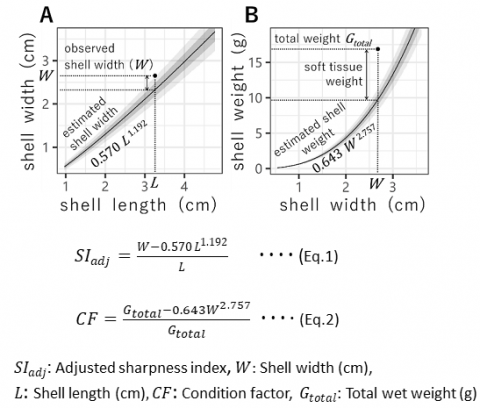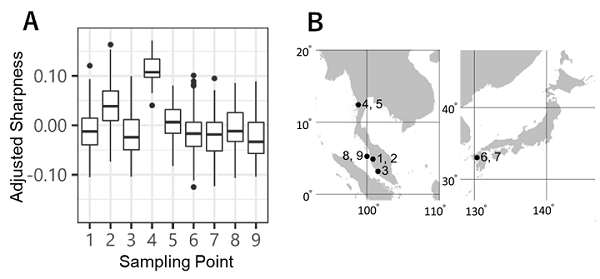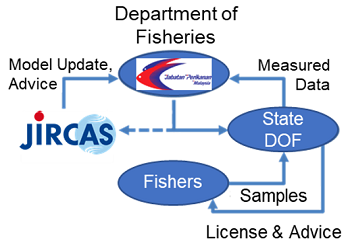Development of conventional biological indices for evaluation and management of blood cockle fishing/aquaculture grounds
Description
The blood cockle, Tegillarca granosa (Fig. 1), is an especially important fisheries resource for Southeast Asia. It is rich in minerals and vitamins, and is an indispensable ingredient in traditional dishes to improve nutritional balance of the local people. These days, production of blood cockle in Southeast Asia is seriously decreasing because of environmental deterioration in the coastal areas where their habitats are. Therefore, appropriate management of the fishing and aquaculture grounds as well as technical measures to recover the bivalve resources are required. For that purpose, easy and economical monitoring techniques are needed to evaluate long- and short- term changes in the bivalve’s living environment.To monitor the condition of the fishing/aquaculture grounds of blood cockle continuously, we developed simple biological indices which can be obtained easily by local fishers. We modified the conventional sharpness index in bivalve shell profiles (shell width / shell length) and applied it to blood cockle to examine its growth conditions. The adjusted sharpness index was deduced from the allometric equation to remove size dependency in the conventional sharpness index (Fig. 2A, Eq. 1). It could be used for blood cockle samples of mixed sizes to detect growth difference between groups from different origins (Fig. 3) to evaluate habitat suitability. For example, a trend in increasing adjusted sharpness index in the same fishing ground suggests environmental deterioration is in progress, causing the growing of the inhabiting blood cockle worse. Thus, we may recommend changing the location of fishing /aquaculture grounds. On the other hand, we examined a new method to estimate the condition factor (soft tissue weight / total wet weight) quickly (Fig. 2B, Eq. 2). We found that shell width can be used as a good estimator of shell weight. The soft tissue weight can be calculated as total wet weight of the bivalve minus total shell weight. In this manner, the condition factor could be calculated from total wet weight and shell width without opening the cockles. A trend in decreasing the condition factor suggests the soft tissue of the blood cockle is getting thinner. Thus, we may recommend harvesting the cockles sooner.
The adjusted sharpness index and the estimated condition factor would provide powerful tools to monitor long- and short-term growth conditions of blood cockles, and to evaluate the condition of its fishing/aquaculture grounds indirectly. The developed biological indices would provide fisheries authorities scientific evidence to make recommendations for blood cockle fishery management. The developed indices can be calculated easily by measuring only three body size variables — length, width, and total weight — using simple tools such as calipers and weighing scales, therefore even fishers can utilize them. JIRCAS has worked together with our counterpart in Malaysia to construct a data collection and monitoring scheme for the management of blood cockle fishing/aquaculture grounds (Fig. 4).
Figure, table
-
Fig. 1. Blood cockles, Tegillarca granosa, collected from Perak, Malaysia (left) and from Linmalo Village, Myanmar (right)
-
Fig 2. Scatter plots to estimate equations for the adjusted sharpness index (A) and the condition factor
Each plot was superimposed with the allometry curve (black line) and 68% (light grey) and 95% (grey) prediction intervals.
-
Fig 3. Adjusted sharpness indices of blood cockles (A) from sampling points (B)
-
Fig 4. Schematic model to monitor and manage blood cockle fishing/aquaculture grounds in Malaysia
- Affiliation
-
Japan International Research Center for Agricultural Sciences Fisheries Division
- Classification
-
Technical
- Research project
- Program name
- Term of research
-
FY2020(FY2016~FY2020)
- Responsible researcher
-
Teoh Hong Wooi ( Xiamen University Malaysia Campus )
Saito Hajime ( Japan Fisheries Research and Education Agency )
- ほか
- Publication, etc.
-
Saito H and Teoh HW (2021) Malaysian Fisheries Journal
- Japanese PDF
-
2020_C10_A4_ja.pdf495.57 KB
2020_C10_A3_ja.pdf495.26 KB
- English PDF
-
2020_C10_A4_en.pdf720.26 KB
2020_C10_A3_en.pdf719.61 KB
- Poster PDF
-
2020_C10_poster.pdf562.35 KB
* Affiliation at the time of implementation of the study.




